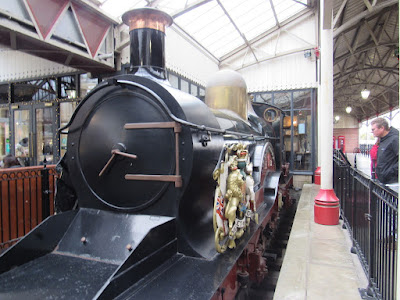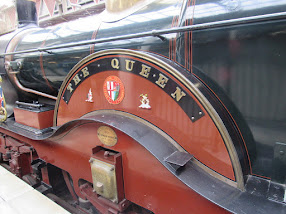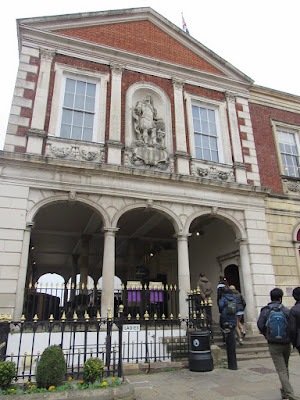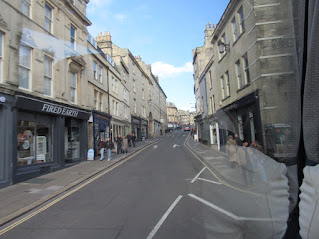Windsor hosts one of the major castles of the kings and queens of England. It has been the seat of the Crown since 1066 when William the Conqueror became king of England after the Battle of Hastings. It started out as a timber castle and eventually was built with stone.
All royal residences were built on rivers so that the sovereign could travel easily, especially if his/her life were in danger. Windsor Castle is no different. It borders the Thames River, which is upstream from London.
Typically, the British monarch resides at Buckingham Palace during the week and then retreats to Windsor on weekends. Although the monarch lives in these palaces, they are not theirs. They are state-owned.
We did not go inside the castle because of the long lines and our limited time in the village. We just looked at it from the outside. However, when I took a business trip to London in 2008, I went on a tour that did go inside Windsor (as well as the Stonehenge and Oxford University). The soldiers in their bearskin helmets and red and black uniforms put on a parade demonstration, and it was most enjoyable--a kind of anglophile delight. On that tour the bus also passed by Ascot, where the exclusive horse races are held. I first heard of Ascot as a young girl listening to the musical "My Fair Lady". In the film, one of the
I enjoyed watching this policewoman direct traffic at the castle's exit. Loved her cape and her enthusiasm.

Windsor is a get-away place that families visit on the weekends. One of the first things visitors see after crossing an elevated bridge from the parking lot is a replica of Queen Victoria's 19th century train.
 The train transported the Queen between Windsor and London beginning on June 13, 1842. During her long reign, from 1837 to 1901, Victoria traveled by train
dozens of times, which was quite adventurous considering that
train travel was relatively new and dangerous at the time. Below is her coat of arms and its name inscribed on the side.
The train transported the Queen between Windsor and London beginning on June 13, 1842. During her long reign, from 1837 to 1901, Victoria traveled by train
dozens of times, which was quite adventurous considering that
train travel was relatively new and dangerous at the time. Below is her coat of arms and its name inscribed on the side.

Queen
Victoria's presence is also depicted on this statue in front of one of
the corners of the castle. She overlooks the marketplace.
 Windsor is filled
with shops, cafés, and restaurants, many of which play on the theme of the royal family. Other shops just have interesting names.Very British indeed!
Windsor is filled
with shops, cafés, and restaurants, many of which play on the theme of the royal family. Other shops just have interesting names.Very British indeed!

This building leans to the left a bit and visitors are anxious to take photos where they are holding up the buildng. This woman was a part of a group of Brazilians who were visiting England.
Windsor is a pleasant little village full of history. Walking down its narrow streets is both interesting and fun as they have a very British flavor.
On the serious side, the Royal Family was still in transition after Queen Elizabeth II died on September 8, 2022. A slab of the street acknowledged her reign by designating it as the Queen's Walkway.
The Guildhall goes back to 1518. It is the earliest surviving government building in Windsor. It was first built in 1369 as a marketplace and town hall. The erection of the present hall was started in 1687, under the direction of Sir Thomas Fitz. After he died, Christopher Wren (1632-1723), a famous and talented British architect completed the project. It is supported by stone columns on its perimeter, but the city fathers were worried that the columns could not support the weight of the building. They wanted additional pillars on the interior of the overhang. Wren disagreed but put in the additional columns--that did not touch the ceiling. This story is a reputed legend, but it makes for rich architectural gossip.
Sir Christopher Wren (1632-1723) was one of the most highly acclaimed English architects in history, as well as an anatomist, astronomer, geometer, and mathematician-physicist. He was accorded responsibility for rebuilding 52 churches in the City of London after the Great Fire in 1666, including what is regarded as his masterpiece, St. Paul's Cathedral, on Ludgate Hill, completed in 1710.
Wren's architectural style was influenced by 1st century Roman architect Vitruvius and the classical works of English architect Inigo Jones. After traveling to Paris he studied French baroque and met Italian Baroque architect Gianlorenzo Bernini. He typically used baroque ideas with classical restraint and influenced Georgian architecture in England and the American colonies.
Since 1974, the guildhall has been used by the Royal Borough of Windsor and Maidenhead council for ceremonies and committee meetings. On April 9, 2005, Prince Charles and Camilla Parker Bowles were married here and on December 21, 2005, Sir Elton John and David Furnish were married in one of the first same sex civil partnership ceremonies of England. On March 12, 2011, Queen Elizabeth II opened the new Windsor and Royal Borough Museum in the Guildhall.
Although a whirlwind tour doesn't allow much depth into the culture or even the places you visit, it does provide a sense of where things are. Meeting new people on the tour is another plus. Generally, I associate with those who sit around me on the bus and then meet up with them in the town we visit and at meals. They come from many different places. Our tour included Americans, Indians, Indonesians, Canadians, Malaysians, Singaporians, and Australians. Traveling alone allows me to mingle with others more easily--and to take the occasional break from the group. In the meantime, the benefit of having a tour company arrange hotels, meals, and transportation as well as to provide background about the places we see is worth the price of the tour.
Resources
Windsor Guildhall -- https://en.wikipedia.org/wiki/Windsor_Guildhall
"The Queen" Locomotive -- https://www.atlasobscura.com/places/the-queen-locomotive-windsor-england
Christopher Wren -- https://en.wikipedia.org/wiki/Christopher_Wren





















































